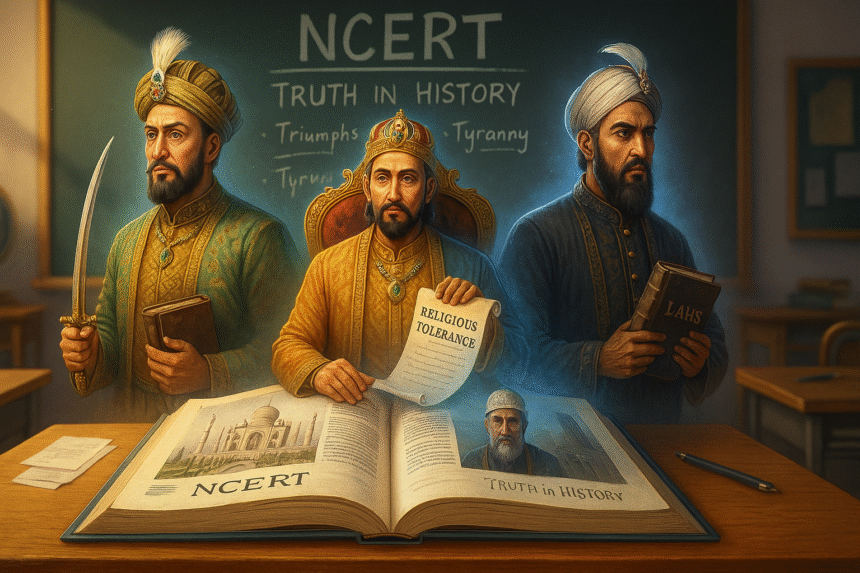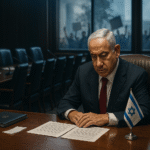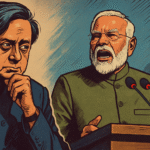History classes in India have long had a reputation for being… well, a little dry. If you’ve ever sat in a classroom staring at black-and-white portraits of emperors while trying not to drool on your notebook, you’re not alone. But hold on to your school bags, kids (and nostalgic adults), because NCERT just dropped a history bomb — and it’s not the usual sanitized saga.
The Class 8 social science textbook is getting a spicy revamp. And this time, it’s not all about glorifying emperors with the aura of divine infallibility. We’re getting the full masala — the bright AND dark sides of three major Mughal rulers: Babur, Akbar, and Aurangzeb.
- History classes in India have long had a reputation for being… well, a little dry. If you’ve ever sat in a classroom staring at black-and-white portraits of emperors while trying not to drool on your notebook, you’re not alone. But hold on to your school bags, kids (and nostalgic adults), because NCERT just dropped a history bomb — and it’s not the usual sanitized saga.
- 🏰 From Regal Reverence to Reality Check
- 🧠 Why This Change is a Big Deal (Like, Really Big)
- 📚 What’s Actually in the Book?
- 🏫 The Classroom Will Never Be the Same
- 🇮🇳 Politics and Public Reactions? You Bet.
- 📈 Will Students Love This New Version?
- 🌟 What We Can Learn from This as a Society
- ✍️ Final Thoughts: Time to Flip the Page
Yes, you read that right. The era of unblemished hero worship in history books is shifting toward a more balanced, realistic, and dare we say, gripping narrative. So, what exactly is happening in those updated NCERT pages, and why does it matter? Let’s unpack this with a dose of historical intrigue and present-day wit.
🏰 From Regal Reverence to Reality Check
For decades, our history books treated certain rulers like Instagram influencers: only the best angles, always glowing, and never caught without a filter. Babur was the great founder, Akbar the benevolent ruler, and Aurangzeb the…well, let’s just say he always got mixed reviews.
But NCERT has decided to give students a peek behind the curtain. The revised Class 8 social science book will now include:
- Babur’s battle strategies and his controversial cultural policies
- Akbar’s policy of religious tolerance and his authoritarian decisions
- Aurangzeb’s administrative reforms alongside his hardline stances and religious intolerance
It’s like switching from a one-star hotel review to the full TripAdvisor experience—warts, wonders, and everything in between.
🧠 Why This Change is a Big Deal (Like, Really Big)
You might wonder, “So what if history books are getting updated? Doesn’t this happen every few years?”
Not quite like this.
This is part of India’s curriculum rationalization process, aiming to make content not only more streamlined but also more truthful and contextual. Rather than spoon-feeding glorified tales, the new approach lets students ask tough questions, develop critical thinking, and form independent opinions.
In short: it’s less “History says so” and more “Let’s analyze why history says so.”
📚 What’s Actually in the Book?
Let’s break it down with some textbook teasers that would make even Mughal Netflix series jealous:
1. Babur – The Founder with a Sword and a Story
We all know he established the Mughal empire in India. But the book also explores his memoirs (Baburnama), his thoughts on India’s landscape, and how his campaigns affected the indigenous population.
2. Akbar – The Great (and Occasionally Gritty)
Yes, he built Fatehpur Sikri and championed Sulh-e-Kul, a philosophy of universal peace. But the new book also questions his imperial ambitions, court politics, and the pressures he placed on regional leaders. It’s Akbar like you’ve never read him before — not just a wise monarch, but a complex figure navigating power.
3. Aurangzeb – The Administrator and the Enforcer
He’s been one of the most polarizing figures in Indian history. The updated textbook doesn’t shy away from that. Students will learn about his massive empire and reforms, as well as his temple destruction orders, religious policies, and resistance from Rajputs, Sikhs, and Marathas. Spoiler: it’s not a bedtime story.
🏫 The Classroom Will Never Be the Same
Teachers will now face a fascinating challenge: how to teach nuance.
Gone are the days of, “Repeat after me: Akbar was great.” Instead, classrooms will echo with questions like:
- “Was Aurangzeb a tyrant or a misunderstood strategist?”
- “Did Akbar’s religious policy truly unite India?”
- “Why did Babur feel like a stranger in the land he conquered?”
This isn’t just curriculum evolution — it’s classroom revolution.
And let’s not forget the impact on students preparing for UPSC and competitive exams. With more nuanced content, future bureaucrats might finally understand that history isn’t black and white — it’s fifty shades of context.
🇮🇳 Politics and Public Reactions? You Bet.
Whenever historical revisions hit the headlines, political debates aren’t far behind.
Critics argue that rewriting history (or re-righting it) often walks a fine line between academic reform and ideological agenda. Supporters say it’s high time students learned a holistic version of history that doesn’t hide emperors’ mistakes behind velvet curtains.
Social media, of course, did what it does best — meme the moment. One viral tweet read:
“Finally, history class won’t feel like attending a Mughal fan club.”
Some historians, however, are cautiously optimistic. They say it’s a step forward if handled responsibly and with scholarly accuracy.
📈 Will Students Love This New Version?
Well, let’s be real. No matter how much you spice it up, history class still means dates, wars, and long paragraphs. But here’s the twist — storytelling.
By showing emperors as real people with dilemmas, contradictions, and ambitions, this move might actually make history relatable.
Instead of memorizing “Akbar abolished the Jizya tax,” students might now ask: “Why did Akbar abolish the Jizya? What were the consequences?”
See the difference?
🌟 What We Can Learn from This as a Society
History isn’t just about what happened; it’s about how we choose to remember what happened.
With these updates, NCERT seems to be saying: “Let’s not glorify. Let’s not vilify. Let’s understand.”
That’s a powerful message—not just for students, but for all of us scrolling through our polarized feeds, clinging to single-sided narratives.
✍️ Final Thoughts: Time to Flip the Page
The updated Class 8 social science book is more than just ink on paper. It’s a mirror to the past, cracked just enough to reveal all angles. Whether you’re a student, a parent, or someone who still remembers doodling on your history notebook, this change should matter to you.
Because when we teach children to see the past with both eyes open, we empower them to shape a better future — one where facts matter more than fables.
So the next time someone says, “History is boring,” hand them this new NCERT textbook and say:
“Not anymore, my friend. Not anymore.”
📝 TL;DR:
- NCERT’s new Class 8 book presents both bright and dark sides of Babur, Akbar, and Aurangzeb.
- Aims to foster critical thinking and move beyond glorified portrayals.
- Part of broader curriculum reforms to make history more realistic and contextual.
- Politicians, historians, and meme-creators are already buzzing.
- Ultimately, it’s a bold step toward making history human, honest, and harder to ignore.












